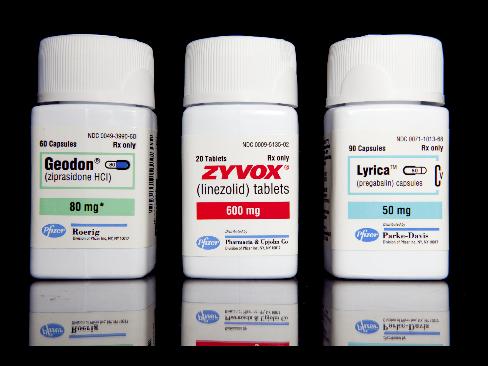Dividend Value Builder Newsletter
- Discover, Compare, and Evaluate Stocks Without Emotional Bias -
(Intrinsic Value Analysis For Over 300 Stocks)
Pfizer (PFE) Dividend Stock Analysis

Pfizer Dividend
The Pfizer dividend has been paid since 1980 and has increased the dividend for 14 consecutive years; qualifying the company as a Dividend Contender. PFE used to be a Dividend Aristocrat until it cut its dividend during the great recession.
Pfizer’s strategic assets (i.e. patents), economies of scale, and an impressive distribution network provide a wide moat. The company has a large diversified portfolio of drugs and a sustaining pipeline of new drugs.
Current Dividend Per Share Annualized: $1.68
Pfizer (PFE) Intrinsic Value – Margin of Safety Analysis
(updated June 2024)
Normalized Earnings Per Share (TTM): -$0.05
Free Cash Flow Per Share (TTM): $0.90
Cash Flow From Operations Per Share (TTM): $1.52
Estimated Intrinsic Value: $31
Target Buy Price Based on Required Margin of Safety = $22
(Required Margin of Safety Based On Risk Stability Grade:
A = 0%, B = 20%, C = 40%, D = 60%, F = 80%)
Target SELL Price Based on Estimated Intrinsic Value = $36
(Allow Overvaluation Adjusted by Risk Stability Grade:
A = 40%, B = 25%, C = 15%, D = 5%, F = 0%)
Risk / Stability Grade: C
A grade indicates a quality company with a strong balance sheet, high earnings quality, and a positive business environment. These stocks require the slimmest margin of safety within the stock universe.
B grade indicates a company with a good balance sheet, good earning quality, and a stable business environment. The margin of safety required should be greater than stocks with an A grade but less than the average stock.
C grade indicates a company with a sufficient balance sheet, at least average earnings quality, and a reasonably stable business environment. The margin of safety required is greater than A & B stocks, but less than D & F stocks.
D grade indicates a company in good standing but has issues that could affect its stability and long term risks. D rated stocks should require a large margin of safety when purchased.
F grade indicates a company with significant issues that are currently affecting its stability and long term risks. Require an extremely large margin of safety for F rated stocks when purchased.
Financial Risk Grade: C
A grade indicates an extremely low probability of a dividend cut. This rating is reserved for companies with strong balance sheets and/or excellent dividend histories.
B grade indicates a very low probability for a dividend cut.
C grade indicates a low probability for a dividend cut and/or average safety risk.
D grade indicates there are issues that should be considered concerning future dividend payments.
F grade indicates serious dividend safety risks. Investors should complete comprehensive due diligence before investing.
Business Quality Grade: D
A grade indicates earnings quality is high or far above average.
B grade indicates earnings quality is good and/or above average.
C grade indicates earnings quality is acceptable or average.
D grade indicates earnings quality is poor and requires thoughtful due diligence.
F grade indicates the quality of the earnings is poor or far below average requiring serious due diligence.
Earnings Report: 3/31/24
AAAMP Portfolios Position Disclosures:
Treasure Trove Dividend (TTD) – None
Global Dividend Value (GDV) – None
Dividend Growth & Income (DGI) – LONG
Global Value (GV) – None
Global Value Aggressive (GVA) – None
Global Conservative Income (GCI) – None
Global Aggressive Income (GAI) – None
Company Description
Sector: Healthcare
Industry: Drug Manufacturers – Major
Pfizer is one of the world’s largest pharmaceutical firms, with annual sales close to $50 billion (excluding COVID-19 product sales). While it historically sold many types of healthcare products and chemicals, now, prescription drugs and vaccines account for the majority of sales.
Top sellers include pneumococcal vaccine Prevnar 13, cancer drug Ibrance, and cardiovascular treatment Eliquis. Pfizer sells these products globally, with international sales representing close to 50% of its total sales. Within international sales, emerging markets are a major contributor.
SWOT Analysis
Strengths
Strategic assets (patents), economies of scale, and barriers to entry are important competitive advantages for Pfizer. Pfizer’s global salesforce and patent-protected drugs produce large amounts of cash flow. This has provided high returns on invested capital and allowed the company to return significant cash to shareholders.
Weaknesses
Biopharmaceutical research & development is expensive, complex, and risky because it requires long periods of time to bring products to market.
Expiration of patent protection is one of Pfizer’s biggest weaknesses. In particular, the loss of Viagra (2017) and Lyrica (2019) have been large challenges for the company. The large decline in COVID-19 vaccine demand has been dramatic and caused large write-offs.
Pfizer is being squeezed from three angles.
Drug approval authorities are becoming more risk adverse.
Buyers are consolidating to increase their purchasing power and demanding lower margins.
Changes in healthcare insurance are putting downward pressure on prices.
Opportunities
Pfizer’s strong position in the industry makes it a great partner for smaller drug companies that don’t have the resources to go it alone. Large cash flows from established products provides R&D capital needed for future growth.
Threats
The majority of Pfizer’s revenues come from a highly regulated and extremely competitive industry. Threats to Pfizer include: loss of patent protection, a more rigorous FDA, managed care co-ops demanding lower prices, a lack of innovation from R&D, healthcare legislation, and litigation.


Dividend Value Builder Newsletter Membership (24 Issues) - $129/Yr.
Minimize Large Portfolio Drawdowns
Invest With Confidence In Less Time - Manage Your Portfolio Without Behavioral Errors
Disclaimer:
While Arbor Investment Planner has used reasonable efforts to obtain information from reliable sources, we make no representations or warranties as to the accuracy, reliability, or completeness of third-party information presented herein. The sole purpose of this analysis is information. Nothing presented herein is, or is intended to constitute investment advice. Consult your financial advisor before making investment decisions.
